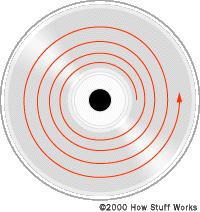|
 
How CDs Work
Source:
"How CDs
Work", HowStuffWorks (http://www.howstuffworks.com), by Marshall Brain.
HowStuffWorks, Inc., 2002
CDs store music and other files in digital form -- that is, the
information on the disc is represented by a series of 1s and 0s. In
conventional CDs, these 1s and 0s are represented by
millions of tiny bumps and flat areas on the disc's reflective surface.
The bumps and flats
are arranged in a continuous track that measures about 0.5 microns
(millionths of a meter) across and 3.5 miles (5 km) long.

To read this information, the
CD player passes a laser beam
over the track. When the laser passes over a flat area in the
track, the beam is reflected directly to an optical sensor on the
laser assembly. The CD player interprets this as a 1. When the beam
passes over a bump, the light is bounced away from the optical
sensor. The CD player recognizes this as a 0.
The
CD player spins the disc while moving
the laser assembly outward from the middle. To keep the
laser scanning the data track at a constant speed, the player must slow
the disc as the assembly moves outward.
At its heart, this is all there is to a
CD player. The execution of this idea is fairly complicated, because the
pattern of the spiral must be encoded and read with incredible precision,
but the basic process is pretty simple.
REPLICATION
The CD fabrication machine uses a high-powered laser to etch the bump
pattern into photoresist material coated onto a glass plate. Through an
elaborate imprinting process, this pattern is pressed onto acrylic discs.
The discs are then coated with aluminum (or another metal) to create the
readable reflective surface. Finally, the disc is
coated with a transparent plastic layer that protects the reflective metal
from nicks, scratches and debris.

DUPLICATION
An alternative sort of CD that could be encoded in a few
easy steps. CD-recordable discs, or CD-Rs, don't have any bumps or flat
areas at all. Instead, they have a smooth reflective metal layer, which
rests on top of a layer of photosensitive dye.
When the disc is blank, the dye is translucent: Light
can shine through and reflect off the metal surface. But when you heat the
dye layer with concentrated light of a particular frequency and intensity,
the dye turns opaque: It darkens to the point that light can't pass
through.
By selectively darkening particular points along the CD
track, and leaving other areas of dye translucent, you can create a
digital pattern that a standard CD player can read. The light from the
player's laser beam will only bounce back to the sensor when the dye is
left translucent, in the same way that it will only bounce back from the
flat areas of a conventional CD. So, even though the CD-R disc doesn't
have any bumps pressed into it at all, it behaves just like a standard
disc.
|